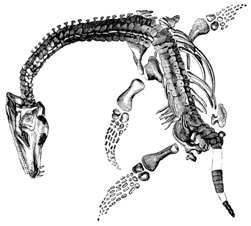Geologist and science writer Nina Morgan discovers that fossil nicknames rule OK!

Although partial skeletons and fragments were reported as early as 1605, plesiosaurs were not officially recognised as a distinct group until much later. The genus was first formally defined by William Conybeare (1787-1857) and Henry de la Beche (1796-1855) in 1821, on the basis of a partial skeleton in the collection of Colonel Thomas Birch. But the most famous – and certainly most controversial – plesiosaur fossil was the nearly complete skeleton found in 1823 by Mary Anning (1799-1847) in Liassic rocks on the coast at Lyme Regis. The fossil of this ‘New Fish’ – actually a marine reptile – broke all the anatomical rules.
William Buckland (1784-1856), first Reader in Geology at Oxford University, likened it to "a turtle threaded through with the body of a snake”. When the preeminent anatomist of the time, the Baron Georges Cuvier (1769-1832) of the Muséum d’Histoire Naturelle in Paris, saw drawings of the Anning specimen, he was, to put it mildly, sceptical. He declared it to be a composite fake, made up by joining the head and neck of a sea snake to the body of an ichthyosaur.
A fanciful report in the February 1865 issue of Charles Dickens’s magazine All the Year Round, described his indignant response:
“Verily, this is altogether the most monstrous animal that has yet been found amid the ruins of a former world. It had a lizard’s head, a crocodile’s teeth, a trunk and tail like an ordinary quadruped, a chameleon’s ribs, a whale’s paddles, whilst its neck was of enormous length, like a serpent tacked on to the body”
But in spite of Cuvier’s misgivings, Mary Anning’s fossil proved to be genuine. The anatomist and vertebrate palaeontologist Richard Owen (1804-1892), who played a key role in the establishment of London’s Natural History Museum, went on to name dozens of new species of plesiosaur. One of these was lent by the palaeontologist and politician, Sir Philip Egerton (1806-1881), a keen collector of fossil fish. In a letter dated October 26 1840, Egerton, wrote to Owen to express his delight at seeing his prize in print:
My dear Owen,
I have just completed the perusal of your first report (‘British Fossil Reptiles’), which is glorious. I feel perfectly sure that the terms in which that report is spoken of by those with whom I have conversed and who are more competent than I am to value its merits, and the public mention of it at [the British Association Meeting in] Glasgow , in the secretaries’ report and elsewhere, must be most gratifying to yourself as they are to me. I can only say that I feel no further regrets at having been the cause of imposing this burden upon you, and shall always consider that, of my humble efforts in furtherance of scientific knowledge, the most important has been that, if not of causing, at all events of accelerating the production of so valuable a report. I am so much delighted with it that I freely forgive you for christening my Plesiosaur “Old Spooney.”
Owen is often characterised in the popular imagination for his attacks on his scientific colleagues. But clearly on this occasion the knives were not out.
Acknowledgments
Sources for this vignette include: Volume one of
The Life of Richard Owen by his grandson The Rev. Richard Owen, MA, John Murray, London, 1894; Mary Anning, The Fossil Finder, in All the Year Round, [conducted by Charles Dickens] February 11, 1865, pp. 60-63; The Life and Correspondence of William Buckland, D.D., F.R.S. by his daughter, Mrs Gordon, John Murray, London, 1894; and the website
http://www.plesiosauria.com/. Thanks also to Dr Adam Stuart Smith, Collections Access Officer (Natural History),Nottingham Natural History Museum, for pointing me towards additional references about pleisiosaurs.
- If the past is the key to your present interests, why not join the History of Geology Group (HOGG). For more information and to read the latest HOGG Newsletter visit the HOGG website at: www.historyofgeologygroup.co.uk, where you’ll also find abstracts for the talks and posters presented at the Conference on Geological Collectors and Collecting, April 2011 available free to download as a pdf file.
*Nina Morgan is a geologist and science writer based near Oxford.